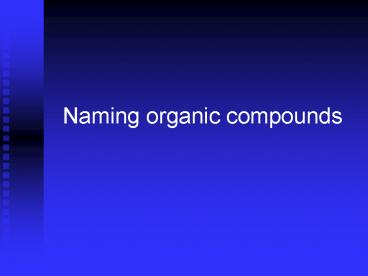Naming organic compounds - PowerPoint PPT Presentation
1 / 18
Title:
Naming organic compounds
Description:
Naming organic compounds Naming organic compounds The basic rules There are some general rules which you should remember when naming organic compounds: The longest ... – PowerPoint PPT presentation
Number of Views:80
Avg rating:3.0/5.0
Title: Naming organic compounds
1
Naming organic compounds
2
Naming organic compounds
- The basic rules
- There are some general rules which you should
remember when naming organic compounds - The longest unbranched chain containing the
functional group is the parent molecule or simply
the longest unbranched chain for alkanes.
Remember that the longest chain can go round a
bend. - Indicate the position of the functional group
with a number, numbering from the end nearest the
functional group. - Name the branches and indicate the number of
branches.
3
- Indicate the position of the branches with a
number, numbering from the end nearest the
functional group.If there is more than one
branch, the branches are identified in
alphabetical order ignoring any di, tri etc. - Be aware!Each branch needs to be numbered
individually, even if they are attached to the
same carbon atom.The rule is a comma between
numbers and a dash between numbers and letters.
4
Naming alkanes, alkenes and alkynes
- Alkanes
- The alkanes don't contain a functional group and
so the branches are numbered from the end that
gives the lowest set of position numbers for the
branches.Use the above rules to see how the
names of the alkanes below are built up.
5
(No Transcript)
6
- Alkenes and alkynes
- The functional group in the alkenes is the carbon
to carbon double bond.The functional group in
the alkynes is the carbon to carbon triple
bond.The basic rules of naming apply.The
position of the double or triple bond is
indicated by a number before the -ene or -yne
part of the name.
7
(No Transcript)
8
Naming alcohols, aldehydes and ketones
- Alcohols
- The functional group in the alcohols is the
hydroxyl group (-OH).Alcohols end in the
letters -olThe basic rules of naming apply.The
position of the hydroxyl functional group is
indicated by a number before the -ol part of the
name.
9
Naming alcohols, aldehydes and ketones
- Be aware!Alcohols can also be termed primary,
secondary or tertiary. - Primary has the -OH on the end of a
chain.Secondary has the -OH on a non-branched
carbon atom along the chain.Tertiary has the -OH
on a branched carbon atom along the chain.
10
Naming alcohols, aldehydes and ketones
11
Naming alcohols, aldehydes and ketones
- Aldehydes
- All aldehydes contain a carbonyl functional
group. The carbonyl group will never have a
position number in an aldehyde as it is always on
the end of the carbon chain.Aldehydes end in
the letters -al.The basic rules of naming apply.
12
Naming alcohols, aldehydes and ketones
13
Naming alcohols, aldehydes and ketones
- Ketones
- Ketones also contain a carbonyl functional group
but in ketones it is never on the end of a carbon
chain.Ketones end in the letters -one.The
naming rules in part 1 apply as before.
14
Naming alcohols, aldehydes and ketones
15
Naming carboxilic acids and esters
- Carboxylic acids contain the carboxyl functional
group (-COOH) The carboxyl group will never have
a position number in a carboxylic acid as it is
always on the end of the carbon
chain.Carboxylic acids end in -oic acid.The
basic rules of naming apply.
16
Naming carboxilic acids and esters
17
Naming carboxilic acids and esters
- An ester is made from an alcohol and a carboxylic
acid.Esters have their own rules for
naming.The first part of the name comes from
the alcohol and it ends with the letters
-yl.The second part of the name comes from the
carboxylic acid and it ends with the letters
-oate.
18
Naming carboxilic acids and esters
Name of Alcohol Name of Carboxylic acid Name of ester
Ethanol propanoic acid ethyl propanoate
Butanol methanoic acid butyl methanoate
Pentanol ethanoic acid pentyl ethanoate































